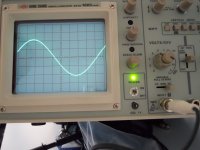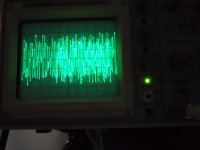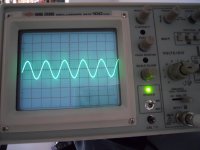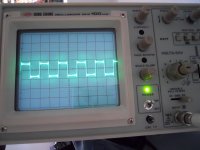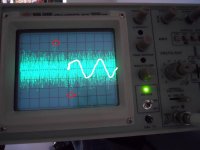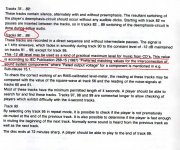I'm not in a position today to do your test, but with the last proto, 6V into a 97dB MB (Re=6.3) driver was unbearable in room with tones or noise within it's passband (<300hz). Measured, 2 speakers and with a Fluke 287 at the terminals.
That's the loudest I could stand being near them with a tone, which I would equate to an average level for dynamic content. Peaks could easily exceed that by 20dB and still be bearable, providing the system is still within it's linear range.
See Bob Cordell's dynamic content and power tests to get what I mean.
I did state later that the proto was 3 way active and I measured the voltage on the LF section as that was least efficient and I wanted to see what was needed. I mainly test with pink noise, full range, but I also measure with tones in the region above the impedance peaks at LF but below xover. Earlier I said it was my Fluke 287, but it might have been the 8010A or Wavetek, but all are true RMS, so the 6V would be RMS. Huge room, distant neighbours.I don't follow. Where is the 6V coming from? Is that what you need to get -20dB RMS at your listening level? Seems rather high, but possible.
If so, that indicates 60V peak, or 450W peak into 8 ohms. Or an RMS rating of about 225W into 8 ohms.
Did you read the Cordell article I linked today?
Did you read the Cordell article I linked today?
Hi Brett, I have seen that and can't dispute any of it as such.
http://www.diyaudio.com/forums/soli...ly-need-domestic-listening-2.html#post2128049
I have a jazz disc somewhere here (I don't like the music) that noodles along at a modest level, which if I set it for a comfortable level at the LP (average of 80dB or so) is nice. Then all the horns come in at once and the difference on that initial note is easily >20dB, based upon your 9-12dB difference, artificially set, then I would be easily into clipping.
Can we look at this from another perspective.
Firstly, we need a reference such as CD (digital) in order to establish known levels. If we had vinyl test discs we could a similar thing of course.
Lets say for a moment this jazz track of yours was on CD.
You say "Then all the horns come in at once and the difference on that initial note is easily >20dB. So you have already set a listening level for your system and presumably it's not distorted. That peak level of the horns we could fairly assume to be near to the 0db level of the medium.
Do you see... it's hard to explain this easily.
You can't take a music track and say that some musical peak level "sounds/appears/mightbe >20db over the average level and so the amp will clip according to this test. You are already listening to that level and proving it OK. That is your current maximum level. And from that figure we can work out an approx amp rating.
Assuming the horns are +20db over the average is just that, an assumption
Work backwards from that, not try and work up to what they may or may not be level wise.
Yes it is the case. A sine wave has a peak voltage that is 3dB higher than its average (RMS) values. There is no doubt about that.
Do you think you made a mistake in the test when you measured 7V on the test tone?
i did it again more carefully.
7.7 volt but it doesnt change much.
Firstly, we need a reference such as CD (digital) in order to establish known levels. If we had vinyl test discs we could a similar thing of course.
Lets say for a moment this jazz track of yours was on CD.
You say "Then all the horns come in at once and the difference on that initial note is easily >20dB. So you have already set a listening level for your system and presumably it's not distorted. That peak level of the horns we could fairly assume to be near to the 0db level of the medium.
Quite right. There is an absolute maximum level with digital playback that is, as you said earlier "set in stone". It does not matter what music or signal is playing, that the highest level possible on the CD. For convenience, we call that 0dB. All other levels must be below that.
Not hard, you've done a great job of it.Do you see... it's hard to explain this easily.

No, 11.31 volts RMS... now there's a coincidenceMaybe ! What's the impedance of a foobar ? Come to that, what's a foobar ?
But we are working in volts today (much nicer) and so we use the magic db =20logv1/v2 do-dah. That tells us that the db thingy for 11.3 volts and 4 volts is 9db or -9db depending which hemishere you are in.
Just like -11.31dB in my hemisphere ...
Yes we can. And I think that perspective is what is tripping up a lot of folks.Mooly said:Can we look at this from another perspective.
We need to think "Top Down" (digital), not "Bottom Up" (analog).
Because digital has an absolute maximum level it becomes a very handy tool for system measurements. If you know what that maximum is, then you know what all other levels are, too. It's pretty easy. Even easier is the fact that most CD/DVD players and DACs output 2V RMS as their maximum level (you should check that for your device). Ergo, all other levels will be below 2V RMS. 2V RMS is the maximum signal possible. 2.83 volts is the absolute maximum peak level. It's "carved in stone" so to speak.
If you measure a test signal that is 12dB RMS below maximum, we know that it's coming out of the CD player at 0.5V RMS. Pass that thru your preamp, volume control and power amp and that voltage will change, of course. It might end up as 5V RMS once it leaves the power amp and hits the speaker. But it's still 12dB below peak- that has not changed. Otherwise said, the peak level that your amp will produce is 4X higher. That's all it can be, unless your amp is clipping or has some other non-linearity.
Another thing that seems to be leading a number of folks astray is the -12dB level - maybe because it's close to the average level of a lot of music. But remember, you did NOT set your volume level to the test tone, did you? No, you set it to music. And on a digital recording that music, no matter what it is, will peak at 0dB, never higher. Your music might have an average level of -22dB, or -10dB or even Tom's fireworks recordings at -40dB. The absolute peak value will never be above 0dB. It can't be.
So why the -12dB test level? It was chosen so that you get a good measurement and don't blow out your speakers or your ears. Imagine that I had asked you to set a very loud level, than had you play a test tone that was recorded at -3dB. You'd complain to me that you had blown out your speakers, burst your eardrums and scared the cat!! (Poor kitty). The test tone could have been at -50dB, but that might mean a voltage so low it's hard to measure on some volt meters.
The test tone level could have been set anywhere, but -12dB seemed a safe and convenient place for it. It's just a happy coincidence that 12dB is 4X voltage for easy math. And even more fun is that the measured voltage squared = the 8 ohm power rating. That one just fell in my lap, I didn't plan it.
Sorry for the long post, but I hope this helps clear up what's going on.
Hehehe I haven't yet got to try the test yet, will have to wait till I have the house to myself. I think I can see where the confusion is as Mooly and Pano have pointed out. I'll try and put it concisely.
Set your reference level using the recording you have with the greatest dynamic range, at the loudest you would listen to THAT recording. Then do the measurement of the test tone
Also as has been pointed out already you should be using the same source for the test tone as for the playback of the recording, otherwise you cannot be sure they are at the same level.
If you use the recording with the highest compression your results will be much lower (and not a true reflection of the voltage you really need).
If you know your music collection you should be able to pick the recordings which you know you normally crank the volume knob up higher on.
Set your reference level using the recording you have with the greatest dynamic range, at the loudest you would listen to THAT recording. Then do the measurement of the test tone
Also as has been pointed out already you should be using the same source for the test tone as for the playback of the recording, otherwise you cannot be sure they are at the same level.
If you use the recording with the highest compression your results will be much lower (and not a true reflection of the voltage you really need).
If you know your music collection you should be able to pick the recordings which you know you normally crank the volume knob up higher on.
The principal of the test:
With digital playback, there is a maximum value "set in stone", so to speak. That value is 0dB. All other levels are below this. Knowing that its easy to figure out what the peak level is - it's 12dB more than your measured voltage. That means peak is 4X the voltage. That's as high as the voltage to your speakers will ever go.
Sorry it was a logic joke and a bad one at that
I don't want to explane it as it might confuse others
Last edited:
Yes, 12dB = 3.98 x voltage. I rounded up to 4 for the sake of easier math. It just means that you'll over estimate the peak voltage by about 0.5%. Fair enough, I think.
For fun with decibels, see here: Decibel Calculator
For fun with decibels, see here: Decibel Calculator
The fact that digital zero represents an absolute maximum seems to pass a lot of people by and I think this thread helps to prove that in one way or another. There is always a lot of talk about you needing huge power for peaks, but this is, imo, grossly exaggerated for the majority of music when played at a 'normal' listening level. And by normal I mean the level you would want to listen to for several hours at a time.
It is, as has been explained here, very easy to actually get a measurement for how much voltage swing you need on the output of your amplifier. That is, being needed to deliver the maximum possible signal level, when using a digital source, that you will ever be capable of encountering with the volume knob set to a certain position.
I typically set the volume level with music then scope the amplifiers output with a sine wave played at 0dB. Even with something like classical music, renowned for having a large dynamic range, this volume can vary quite considerably and this can vary even more so for movies. Interestingly as time goes on movies (at least the small selection that I've got) are seemingly becoming less and less compressed as this allows them a larger range between a normal speaking volume and an explosion. Funny how music is going the other way.
It is, as has been explained here, very easy to actually get a measurement for how much voltage swing you need on the output of your amplifier. That is, being needed to deliver the maximum possible signal level, when using a digital source, that you will ever be capable of encountering with the volume knob set to a certain position.
I typically set the volume level with music then scope the amplifiers output with a sine wave played at 0dB. Even with something like classical music, renowned for having a large dynamic range, this volume can vary quite considerably and this can vary even more so for movies. Interestingly as time goes on movies (at least the small selection that I've got) are seemingly becoming less and less compressed as this allows them a larger range between a normal speaking volume and an explosion. Funny how music is going the other way.
Yes 5th E. Very well put, thanks for that. Your comments explain it better than mine. I thought it was pretty obvious - I was wrong. 
Bada-Bing!Set your reference level using the recording you have with the greatest dynamic range, at the loudest you would listen to THAT recording. Then do the measurement of the test tone
- Set your playback level (hopefully with dynamic music)
- Measure a reference level signal
- Presto, you know the maximum level.
I love the thread and understand the calculation. The part that now concerns me is I find that I often play and 5V and sometimes at 10V (100W@8ohms). My amps are rated for 60W/channel. I have one recording that I occasionally set about 13 V (170W). I am puzzled that the P-Amp overload indicator has never come on. You would think that once the rail V has been reached the distortion would rise very quickly and trigger the indicator? Do these indicators only come on under very gross overload? Oh, maybe they are just monitoring a total current limit instead of distortion?
[I use a couple Rotel 6 channel amps (3 stereo amps per unit) It’s a 5.2 channel setup using active XOs for all 12 drivers. A MW and a TW share a stereo amp. I shudder to think how overloaded the 2 60W channels are that drive the 2 SWs.]
That said, there is no indication in the sound that there is an issue. Although I am aware that any higher setting starts turning nasty.
Are others finding acceptable sound with this much overload/clipping?
Any chance we can get a -12 dB test tone maybe in the 30 to 60 Hz range for a SW test and maybe in the 3k to 5k range for a TW test?
[I use a couple Rotel 6 channel amps (3 stereo amps per unit) It’s a 5.2 channel setup using active XOs for all 12 drivers. A MW and a TW share a stereo amp. I shudder to think how overloaded the 2 60W channels are that drive the 2 SWs.]
That said, there is no indication in the sound that there is an issue. Although I am aware that any higher setting starts turning nasty.
Are others finding acceptable sound with this much overload/clipping?
Any chance we can get a -12 dB test tone maybe in the 30 to 60 Hz range for a SW test and maybe in the 3k to 5k range for a TW test?
Ask and you shall receive.  Below you'll find a 30Hz-60Hz sweep and a 3000-5000Hz sweep. Both mono, 20 secs long. Please be careful with your tweeters and the high sweep.
Below you'll find a 30Hz-60Hz sweep and a 3000-5000Hz sweep. Both mono, 20 secs long. Please be careful with your tweeters and the high sweep.
I don't know how well inexpensive meters will measure the 3K-6K tone. I've found that they drop of a few dB up there. If you can measure the output of your CD player directly and compare to the 120Hz tone, then you'll have an idea of how accurate your meter is at 3K-6K.
JT. If you find that your volume setting gives you 10V or even 13V on the -12dB tone, then you must be clipping your 60W amps. Unless those particular recording just don't hit 0dB, or very rarely do. I have some quiet classic tracks like that.
Of course if you are dividing up the spectrum across several amps with an active crossover, that another ball game. The average level of each will be reduced, of course, because it only gets a part. There can be the odd high peak inside a frequency range, but I find that rare in actual recordings.
I don't know how well inexpensive meters will measure the 3K-6K tone. I've found that they drop of a few dB up there. If you can measure the output of your CD player directly and compare to the 120Hz tone, then you'll have an idea of how accurate your meter is at 3K-6K.
JT. If you find that your volume setting gives you 10V or even 13V on the -12dB tone, then you must be clipping your 60W amps. Unless those particular recording just don't hit 0dB, or very rarely do. I have some quiet classic tracks like that.
Of course if you are dividing up the spectrum across several amps with an active crossover, that another ball game. The average level of each will be reduced, of course, because it only gets a part. There can be the odd high peak inside a frequency range, but I find that rare in actual recordings.
Attachments
OK, if you are getting 7.7V on the -12dB tone, then your peak voltage will never be more than 30.8V. Into your minimum load that means 350W, peak. An amp honestly rated at 160W RMS @ 3 ohms should be able to that.i did it again more carefully.
7.7 volt but it doesnt change much.
Maybe this will help folks understand about the levels...
I ran a couple of tests earlier as I have a Philips Audio Test Disc that contains precisely recorded material at various levels. A similar Denon test disc was also available. Of particular interest is the text in the piccy below on "average" music levels off disc.
Measuring 0db off disc (the player was a portable if you wonder why levels are low) gave a reading of 0.765 volts RMS for both test discs.
The -12 db Philips tracks were then played and was at 0.191 volts RMS. Calculator out and that came to -12.05db.
I then played Pano's tracks and they came out at 0.271 volts RMS which calculates out to -9db relative to the test disc 0db reference.
Lets try and explain that...
The scope shot shows 0db level on a sine wave.
The white noise test shows the level going "over" the 0db point. This is where Pano says,
And to show graphically the difference in amplitudes between three differing test waveforms we have shots of sine, square and white noise ALL at -12 db The last scope shot has the 0db sine wave drawn in.

I ran a couple of tests earlier as I have a Philips Audio Test Disc that contains precisely recorded material at various levels. A similar Denon test disc was also available. Of particular interest is the text in the piccy below on "average" music levels off disc.
Measuring 0db off disc (the player was a portable if you wonder why levels are low) gave a reading of 0.765 volts RMS for both test discs.
The -12 db Philips tracks were then played and was at 0.191 volts RMS. Calculator out and that came to -12.05db.
I then played Pano's tracks and they came out at 0.271 volts RMS which calculates out to -9db relative to the test disc 0db reference.
Lets try and explain that...
The scope shot shows 0db level on a sine wave.
The white noise test shows the level going "over" the 0db point. This is where Pano says,
[*]The test signal is recorded at -12dBFS (12dB RMS below Full Scale)
[*]The highest a sine wave can be recorded without clipping is -3dB RMS[/list]
And to show graphically the difference in amplitudes between three differing test waveforms we have shots of sine, square and white noise ALL at -12 db The last scope shot has the 0db sine wave drawn in.
Attachments
- Home
- Loudspeakers
- Multi-Way
- A Test. How much Voltage (power) do your speakers need?

